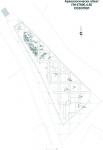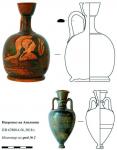Summary (English)
APOLLONIA (Krastina Panaiotova – kpanayotova@abv.bg, Margarit Damyanov) A pit, eight graves (burial pits dug into the bedrock) and a ritual hearth were excavated. The pit measured c. 2.70 m by 2.10 m and contained sherds from amphorae, black-gloss vessels, a lopas and jugs. The burials were inhumations, with bodies laid supine, oriented to the east. The bodies in three graves were laid in wooden coffins. Holes were discovered in the four corners of Grave No. 2, probably to accommodate the legs of a wooden funerary kline. The grave goods included an askos, a red-figure lekythos showing Athena, a black-gloss amphoriskos, alabastra, a cup and terracotta figurines. The burials and the ritual hearth dated to 425 – 400 BC. A patch was discovered, containing charcoal from oak timber, single bones and sherds from a jug, two black-gloss bolsals, a lekythos, an askos and three black-gloss small bowls. Other finds from the excavations included a lead bucranium, a bronze coin of Apollonia and a funerary stele with inscription that reads: ΠΡOKITH AΛKIMAXO. The name Προκίτη occurred for the first time in the Greek onomastics. The name might have actually been Προκρίτη with the letter rho missing; again, it has not been attested so far, but its male form is Πρόκριτος, known from Miletos, the metropolis of Apollonia, and from other Milesian colonies. The patronymic name Ἀλκίμαχος is aristocratic and often occurred, including in Miletos. Two trenches from ancient agricultural activities were discovered, situated at c. 90 cm from each other, 60 cm wide and 2.30 m and 3 m long.
- Krastina Panaiotova - Archaeological Institute with Museum
- Margarit Damyanov - Archaeological Institute with Museum
Director
- Krastina Panaiotova - Archaeological Institute with Museum
- Margarit Damyanov - Archaeological Institute with Museum
Team
Research Body
- Archaeological Institute with Museum






![Download [PDF]](/excavation/skins/fasti/images/results/download_sml.png)

